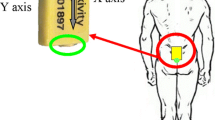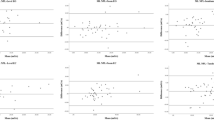Abstract
Purpose
The focus of this study was to monitor daily objective measures of standing postural control over an 8-week period, recorded in a person’s home, in a population of healthy older adults. Establishing natural patterns of variation in the day-to-day signal, occurring in the relative absence of functional decline or disease, would enable us to determine thresholds for changes in postural control from baseline that could be considered clinically important.
Methods
Eighteen community-dwelling older adults (3 M, 15 F, 72 ± 6 years) participated in a home-based trial where each day they were asked to complete a technology-enabled routine consisting of a short questionnaire, as well as a quiet standing balance trial. Centre of pressure (COP) excursions were calculated over the course of each daily balance trial to generate variables such as postural sway length and mean sway frequency.
Results
The data demonstrated large differences between subjects in centre of pressure measures (coefficients of variation ranging 37–107 %, depending on the variable). Each participant also exhibited variations in their day-to-day trials (e.g. coefficients of variation across 8 weeks ranging ~17–56 %, within person for mean COP distance). Inter- and intra-subject differences were not strongly related to functional tests, suggesting that these variations were not necessarily aberrant movement patterns, but are seemingly representative of natural movement variability.
Conclusions
The idea of applying a group-focused approach at an individual level may result in misclassifying important changes for a particular individual. Early detection of deterioration can only be achieved through the creation of individual trajectories for each person, that are inherently self referential.





Similar content being viewed by others
Abbreviations
- BBS:
-
Berg Balance Scale
- COP:
-
Centre of pressure
- ICC:
-
Intra-class coefficient
- MDC:
-
Minimal detectable change
- SEM:
-
Standard error of measurement
- TUG:
-
Timed-up-and-Go
- WBB:
-
Wii balance board
References
Bartlett HL, Ting LH, Bingham JT (2014) Accuracy of force and center of pressure measures of the Wii balance board. Gait Posture 39(1):224–228. doi:10.1016/j.gaitpost.2013.07.010
Bravo G, Potvin L (1991) Estimating the reliability of continuous measures with cronbach’s alpha or the intraclass correlation coefficient: toward the integration of two traditions. J Clin Epidemiol 44(4–5):381–390. doi:10.1016/0895-4356(91)90076-L
Cavalheiro G, Almeida M, Pereira A, Andrade A (2009) Study of age-related changes in postural control during quiet standing through Linear Discriminant Analysis. BioMed Eng OnLine 8(1):35
Cham R, Perera S, Studenski SA, Bohnen NI (2007) Striatal dopamine denervation and sensory integration for balance in middle-aged and older adults. Gait Posture 26(4):516–525
Chang JO, Levy SS, Seay SW, Goble DJ (2013a) An alternative to the balance error scoring system: using a low-cost balance board to improve the validity/reliability of sports-related concussion balance testing. Clin J Sport Med (Publish ahead of print)
Chang W, Chang W, Lee C, Feng C (2013b) Validity and reliability of Wii fit balance board for the assessment of balance of healthy young adults and the elderly. J Phys Ther Sci 25(10):1251–1253
Clark RA, Bryant AL, Pua Y, McCrory P, Bennell K, Hunt M (2010) Validity and reliability of the Nintendo Wii balance board for assessment of standing balance. Gait Posture 31(3):307–310
Clark RA, McGough R, Paterson K (2011) Reliability of an inexpensive and portable dynamic weight bearing asymmetry assessment system incorporating dual Nintendo Wii balance boards. Gait Posture 34(2):288–291
de Vet HCW, Terluin B, Knol DL, Roorda LD, Mokkink LB, Ostelo RWJG, Hendriks EJM, Bouter LM, Terwee CB (2010) Three ways to quantify uncertainty in individually applied “minimally important change” values. J Clin Epidemiol 63(1):37–45
Doheny EP, Greene BR, Foran T, Cunningham C, Fan CW, Kenny RA (2012) Diurnal variations in the outcomes of instrumented gait and quiet standing balance assessments and their association with falls history. Physiol Meas 33(3):361
Doyle RJ, Hsiao-Wecksler ET, Ragan BG, Rosengren KS (2007) Generalizability of center of pressure measures of quiet standing. Gait Posture 25(2):166–171
Dutta A, Kumar R, Malhotra S, Chugh S, Banerjee A, Dutta A (2013) A low-cost point-of-care testing system for psychomotor symptoms of depression affecting standing balance: a preliminary study in India. Depress Res Treat 2013:8. doi:10.1155/2013/640861
Flansbjer U-B, Blom J, Brogardh C (2012) The reproducibility of berg balance scale and the single-leg stance in chronic stroke and the relationship between the two tests. PM&R 4:165–170
Forte R, Boreham CG, De Vito G, Ditroilo M, Pesce C (2014) Measures of static postural control moderate the association of strength and power with functional dynamic balance. Aging Clin Exp Res 1–9. doi:10.1007/s40520-014-0216-0
Fritz S, Lusardi M (2009) White paper: “walking speed: the sixth vital sign”. J Geriatr Phys Ther 32(2):46–49
Gao X, Chen H, Schwarzschild MA, Logroscino G, Ascherio A (2008) Perceived imbalance and risk of Parkinson’s disease. Mov Disord 23(4):613–616. doi:10.1002/mds.21919
Geh CLM, Beauchamp MR, Crocker PRE, Carpenter MG (2011) Assessed and distressed: white-coat effects on clinical balance performance. J Psychosom Res 70(1):45–51
Goldberger AL (2001) Heartbeats, hormones, and health: is variability the spice of life? Am J Respir Crit Care Med 163(6):1289–1290
Hsu W-L, Lin K-H, Yang R-S, Cheng C-H (2014) Use of motor abundance in old adults in the regulation of a narrow-based stance. Eur J Appl Physiol 114(2):261–271. doi:10.1007/s00421-013-2768-7
Hubbard R, Eeles E, Rockwood M, Fallah N, Ross E, Mitnitski A, Rockwood K (2011) Assessing balance and mobility to track illness and recovery in older inpatients. J Gen Intern Med 26(12):1471–1478. doi:10.1007/s11606-011-1821-7
Kaye JA, Maxwell SA, Mattek N, Hayes TL, Dodge H, Pavel M, Jimison HB, Wild K, Boise L, Zitzelberger TA (2011) Intelligent systems for assessing aging changes: home-based, unobtrusive, and continuous assessment of aging. J Gerontol Ser B Psychol Sci Soc Sci 66B(suppl 1):i180–i190. doi:10.1093/geronb/gbq095
Krause KE, McIntosh EI, Vallis LA (2012) Sarcopenia and predictors of the fat free mass index in community-dwelling and assisted-living older men and women. Gait Posture 35(2):180–185
Kurz I, Oddsson L, Melzer I (2013) Characteristics of balance control in older persons who fall with injury—a prospective study. J electromyogr kinesiol off J Int Soc Electrophysiol Kinesiol 23(4):814–819
Kyvelidou A, Harbourne RT, Stuberg WA, Sun J, Stergiou N (2009) Reliability of center of pressure measures for assessing the development of sitting postural control. Arch Phys Med Rehabil 90(7):1176–1184
Lafond D, Hn Corriveau, HÃbert R, Fo Prince (2004) Intrasession reliability of center of pressure measures of postural steadiness in healthy elderly people. Arch Phys Med Rehabil 85(6):896–901
Lin D, Seol H, Nussbaum MA, Madigan ML (2008) Reliability of COP-based postural sway measures and age-related differences. Gait Posture 28(2):337–342
Makizako H, Shimada H, Doi T, Park H, Yoshida D, Uemura K, Tsutsumimoto K, Liu-Ambrose T, Suzuki T (2013) Poor balance and lower gray matter volume predict falls in older adults with mild cognitive impairment. BMC Neurol 13(1):102
McGinnis P, Wainwright S, Hack L, Nixon-Cave K, Michlovitz S (2010) Use of a Delphi panel to establish consensus for recommended uses of selected balance assessment approaches. Physiother Theory Pract 26:358–373
Muir S, Berg K, Chesworth B, Klar N, Speechley M (2010) Quantifying the magnitude of risk for balance impairment on falls in community-dwelling older adults: a systematic review and meta-analysis. J Clin Epidemiol 63(4):389–406
Pagnacco G, Wright CHG, Oggero E, Bundle MW, Carrick FR (2013) On “Comparison of a laboratory grade force platform with a Nintendo Wii balance board on measurement of postural control in single-leg stance balance tasks” by Huurnink, A, et al. [J. Biomech 46(7) (2013) 1392]: are the conclusions stated by the authors justified? J of Biomech 47(3). doi:10.1016/j.jbiomech.2013.06.039
Pajala S, Era P, Koskenvuo M, Kaprio J, Törmäkangas T, Rantanen T (2008) Force platform balance measures as predictors of indoor and outdoor falls in community-dwelling women aged 63–76 years. Theh J of Gerontol Ser A Biol Sci Med Sci 63(2):171–178
Pardasaney P, Latham N, Jette A, Wagenaar R, Ni P, Slavin M, Bean J (2012) Sensitivity to change and responsiveness of four balance measures for community-dwelling older adults. Phys Ther 92:388–397
Piirtola M, Era P (2006) Force platform measurements as predictors of falls among older people: a review. Gerontology 52:1–16
Pollock C, Eng J, Garland S (2011) Clinical measurement of walking balance in people post stroke: a systematic review. Clin Rehabil 25:693–708
Prieto TE, Myklebust JB, Hoffman RG, Lovett EG, Myklebust BM (1996) Measures of postural steadiness: differences between healthy young and elderly adults. IEEE Trans Biomed Eng 43(9):956–966
Ratcliffe SJ, Shults J (2008) GEEQBOX: a MATLAB toolbox for generalized estimating equations and quasi-least squares. J Stat Soft 25(14):1–14
Ruhe A, Fejer R, Walker B (2010) The test–retest reliability of centre of pressure measures in bipedal static task conditions—a systematic review of the literature. Gait Posture 32(4):436–445
Schoene D, Wu SMS, Mikolaizak AS, Menant JC, Smith ST, Delbaere K, Lord SR (2013) Discriminative ability and predictive validity of the Timed up and Go test in identifying older people who fall: systematic review and meta-analysis. J Am Geriatr Soc 61(2):202–208. doi:10.1111/jgs.12106
Shimada H, Tiedemann A, Lord SR, Suzukawa M, Makizako H, Kobayashi K, Suzuki T (2011) Physical factors underlying the association between lower walking performance and falls in older people: a structural equation model. Arch Gerontol Geriatr 53(2):131–134
Shrout PE, Fleiss JL (1979) Intraclass correlations: uses in assessing rater reliability. Psychol Bull 86(2):420–428
Sibley K, Straus S, Inness E, Salbach N, Jaglal S (2013) Clinical balance assessment: perceptions of commonly-used standardized measures and current practices among physiotherapists in Ontario, Canada. Implement Sci 8(1):33
Stergiou N, Harbourne RT, Cavanaugh JT (2006) Optimal movement variability: a new theoretical perspective for neurologic physical therapy. J Neurol Phys Ther 30(3):120–129
Suttanon P, Hill KD, Said CM, LoGiudice D, Lautenschlager NT, Dodd KJ (2012) Balance and mobility dysfunction and falls risk in older people with mild to moderate Alzheimer disease. Am J Phys Med Rehabil 91(1):12–23. doi:10.1097/PHM.1090b1013e31823caeea
Telenius E, Engedal K, Bergland A (2013) Physical performance and quality of life of nursing-home residents with mild and moderate dementia. Int J Environ Res Public Health 10(12):6672–6686
Terwee CB, Roorda LD, Knol DL, De Boer MR, De Vet HCW (2009) Linking measurement error to minimal important change of patient-reported outcomes. J Clin Epidemiol 62(10):1062–1067
Terwee CB, Roorda LD, Dekker J, Bierma-Zeinstra SM, Peat G, Jordan KP, Croft P, de Vet HCW (2010) Mind the MIC: large variation among populations and methods. J Clin Epidemiol 63(5):524–534
Tracy B (2007) Force control is impaired in the ankle plantarflexors of elderly adults. Eur J Appl Physiol 101(5):629–636. doi:10.1007/s00421-007-0538-0
Tsang WN, Lam NY, Lau KL, Leung HH, Tsang CS, Lu X (2013) The effects of aging on postural control and selective attention when stepping down while performing a concurrent auditory response task. Eur J Appl Physiol 113(12):3021–3026. doi:10.1007/s00421-013-2740-6
Verdecchia P, Staessen JA, White WB, Imai Y, O’Brien ET (2002) Properly defining white coat hypertension. Eur Heart J 23(2):106–109
Weir JP (2005) Quantifying test–retest reliability using the intraclass correlation coefficient and the SEM. J Strength Cond Res 19(1):231–240
Winter D, Prince F, Frank J, Powell C, Zabjek K (1996) Unified theory regarding A/P and M/L balance in quiet stance. J Neurophysiol 75:2334–2343
Wright A, Hannon J, Hegedus EJ, Kavchak AE (2012) Clinimetrics corner: a closer look at the minimal clinically important difference (MCID). J Man Manip Ther 20(3):160–166
Young W, Ferguson S, Brault S, Craig C (2011) Assessing and training standing balance in older adults: a novel approach using the ‘Nintendo Wii’ Balance Board. Gait Posture 33(2):303–305. doi:10.1016/j.gaitpost.2010.10.089
Acknowledgments
This research was completed as part of a wider programme of research within the TRIL Centre (Technology Research for Independent Living). The TRIL Centre is a multidisciplinary research centre, bringing together researchers from UCD, TCD, NUIG & Intel, funded by Intel, GE and IDA Ireland.
Conflict of interest
The authors declare no conflict of interest.
Author information
Authors and Affiliations
Corresponding author
Additional information
Communicated by Dick F. Stegeman.
Rights and permissions
About this article
Cite this article
McGrath, D., Greene, B.R., Sheehan, K. et al. Stability of daily home-based measures of postural control over an 8-week period in highly functioning older adults. Eur J Appl Physiol 115, 437–449 (2015). https://doi.org/10.1007/s00421-014-3034-3
Received:
Accepted:
Published:
Issue Date:
DOI: https://doi.org/10.1007/s00421-014-3034-3




